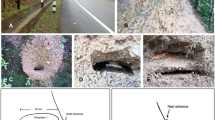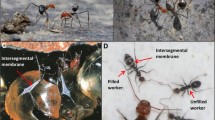Summary.
Polygyny, the presence of several mated queens within the same colony, is widespread in insect societies. This phenomenon is commonly associated with ecological constraints such as limited nest sites. In habitats where solitary nest foundation is risky, monogynous colonies can reintegrate young daughter queens (secondary polygyny). We studied the reproductive structure (i.e. queen number) of the ectatommine ant Ectatomma tuberculatum from Bahia State, Brazil. This species was found to present facultative polygyny: out of a total of 130 colonies collected, 39.2% were monogynous, while 43.8% were polygynous. Polygynous colonies had significantly more workers than monogynous ones. Queen number in polygynous colonies ranged from 2 to 26, with an average of 4 ± 4 queens per colony. All nestmate queens were egg-layers with no apparent dominance hierarchy or agonistic behavior. Non-nestmate queens were adopted by monogynous colonies suggesting that polygyny is secondary, originating through queen adoption. This species is characterized by an open recognition system, which probably allows a switch from monogynous to polygynous colonies. The behavioral acts of queens showed that resident queens remained frequently immobile on or near the brood, contrarily to alien or adopted queens and gynes. In addition, monogynous queens showed no behavioral or physiological (i.e. by ovarian status) differences in comparison with polygynous ones. Secondary or facultative polygyny, probably associated with queen adoption, may have been favored in particular environmental conditions. Indeed, by increasing colony productivity (i.e. number of workers) and territory size (by budding and polydomy), polygyny could uphold E. tuberculatum as a dominant species in the mosaic of arboreal ants in Neotropical habitats.
Similar content being viewed by others
Author information
Authors and Affiliations
Corresponding author
Additional information
Received 7 April 2004; revised 11 November 2004; accepted 15 November 2004.
Rights and permissions
About this article
Cite this article
Hora, R.R., Vilela, E., Fénéron, R. et al. Facultative polygyny in Ectatomma tuberculatum (Formicidae, Ectatomminae). Insectes Soc. 52, 194–200 (2005). https://doi.org/10.1007/s00040-004-0794-5
Issue Date:
DOI: https://doi.org/10.1007/s00040-004-0794-5




